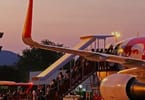BANGKOK, Thailand (eTN) – The occupation of both Bangkok airports for a week continues to generate harsh criticism and incomprehension from the entire travel industry.
It is well known in Thailand that the Airports Authority of Thailand (AOT) does not belong to the top airport’s authorities in terms of commercial and strategic management. To realize how far is AOT from a “traditional” airport’s company, it is good to know that some of its airports directors in the provinces (AOT manages airports in Chiang Mai, Chiang Rai, Hat Yai and Phuket beyond Bangkok) do not even speak English which is a problem when the director has to deal with representatives from foreign airlines.
It is worth to pay also a look to AOT Website (www2.airportthai.co.th/airportnew/main/index.asp?lang=en). Interested travelers will neither find a timetable or information on delayed departure and arrivals or an apology after what happened at the end of November.
The argument that AOT main duty is to assure a basic smooth operation on a daily basis is fair, except that it showed its complete inability to handle the recent political protest that culminated to the complete closure of both Bangkok airports for a week.
Ten days after the dramatic events that saw hundred thousand of passengers stranded, the debate rages about AOT responsibility. The airport’s authority has been quick to put the blame on the People Alliance for Democracy (PAD), which seized both airports, threatening to sue them in court. According to the Bangkok Post, the Board of Directors blamed Suvarnabhumi airport director Serirat Prasutanond for closing the airport on November 25 prior to notifying his decision to the relevant authorities. Airlines were left in complete confusion as AOT and Thai Airways staff abandoned their post. “I went to the airport around midnight and was surprised to see that they were no staff anymore to take care of the passengers. It was a complete mess as it was also impossible to get information on what would happen,” recalled one manager from a foreign airline.
“What happened was a real disgrace for the country. It is also worrying to learn that protesters managed to access the control tower and block departures and arrivals,’’ said Pornthip Hirunkate, secretary general of the Tourism Council of Thailand, a private association of professionals of the tourism sector. “At least, if AOT could not prevent the events, they should have put into action a contingency plan. Especially as they already had to face last August the closure of Phuket and Hat Yai airports for the same reasons.” Most of the Thai travel industry expresses the same anger for AOT lack of action.
Mr. Serirat has offered to resign from his position as acting president of AOT but the demand was rejected by AOT board of directors. The debate now moves to a more legal issue over compensations. Immobilizing aircraft and staff for a week was extremely costly for many airlines. If Brian Sinclair-Thompson, head of the Board of Airlines Representatives and director of Swiss International Airlines, does not opt for official compensation, meanwhile he hopes that AOT will revise its charges and offer some incentive breaks on landing and parking fees. “It would be a sign of goodwill as airlines now struggle to recover from Thailand’s political crisis,” he said.
For Tony Fernandes, present in Thailand to launch AirAsia’s new campaign “Get your Baht to Thailand” to encourage travelers to come to the country, crisis time should give AOT an opportunity to look back at its way to do business. “Bangkok airports are among the most expensive in the region as AOT never looked to seriously provide the right incentives for low-cost carriers such as a low cost terminal. Bangkok has then missed the opportunity to become a major hub for low cost airlines and we still think twice before opening new routes from provincial airports as they remain more expensive than other similar airports in the region,” he said.
Asked if AirAsia would be ready to invest into a low-cost terminal, Fernandes said that he is ready to move in. He said: “We would need a terminal for at least 15 million passengers annually. However, the Thai government must also allow more private money to go into air transport infrastructures.”
Tourism Authority of Thailand (TAT) and AirAsia launched a major initiative to boost confidence of foreign and domestic travelers to fly again. The airline is offered 100,000 free seats from December 16 to 18 to fly to or within Thailand. AirAsia regularly publishes on the Internet this kind of attractive offer. However, in the current gloom faced by airlines in Thailand, the campaign “Get your Baht to Thailand” is a show of confidence into the destination.
“With TAT, we invest Bht 300 million (US$ 8.6 million) to promote Thailand through our various websites and through campaigns all around the world. Thailand gave us lots of good in the past. This is our turn to show now our gratitude to the Kingdom,” Fernandes said.
TAT Governor Pornisiri Manoharn welcomed AirAsia’s initiative and explained that Thailand tourism authority is currently looking to launch similar offers with other airlines. “ We will host an Amazing Thailand-Amazing Value” fair at Queen Sirikit Convention Centre on December 20 and 21 with very attractive packages,” she said.
In another show of confidence, AirAsia announced also that it will open two new routes by the end of January. “As many other airlines cut their routes, the opening of two new routes are the best sign of our confidence into the destination,” added Fernandes. The two new routes will be a daily flight to Bali and Guangzhou.
According to Thai AirAsia CEO Tassapon Bijleveld, TAA is already on the path to recovery with load factors reaching the 80 percent mark. The airline will see its 15th aircraft, an Airbus A320, joining by January with at least two more aircraft being added during the year. “We still have plans to further expand next year. We will definitely start flying to India and add more routes to China. We also look to fly to Danang or Hue in Vietnam,” he said.
QUÈ TREURE D'AQUEST ARTICLE:
- To realize how far is AOT from a “traditional” airport's company, it is good to know that some of its airports directors in the provinces (AOT manages airports in Chiang Mai, Chiang Rai, Hat Yai and Phuket beyond Bangkok) do not even speak English which is a problem when the director has to deal with representatives from foreign airlines.
- The argument that AOT main duty is to assure a basic smooth operation on a daily basis is fair, except that it showed its complete inability to handle the recent political protest that culminated to the complete closure of both Bangkok airports for a week.
- For Tony Fernandes, present in Thailand to launch AirAsia's new campaign “Get your Baht to Thailand” to encourage travelers to come to the country, crisis time should give AOT an opportunity to look back at its way to do business.






















